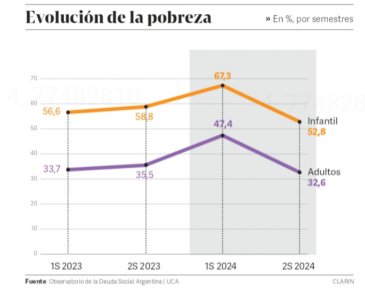earlyretirement
Moderator
Poverty Rates Falling in Argentina Under President Milei
According to the Argentine Social Debt Observatory (UCA), child poverty in Argentina fell from 67.3% in the first half of 2024 to 52.8% by the end of that year, representing a decrease of 14.5 percentage points.
This improvement is mainly attributed to three factors linked to the government of Javier Milei: the slowdown in inflation, the stability of the dollar, and the strengthening of the Universal Child Allowance (AUH), along with the expansion of the Food Card for children up to 17 years old.
Although child poverty remains high, this reduction marks a significant improvement and places the current rate 8 percentage points below the level recorded at the end of Alberto Fernández’s administration, thus consolidating progress compared to the previous government.
The report also highlights that this improvement was not uniform across the country, with strong regional contrasts: while the City of Buenos Aires has the lowest child poverty rate (27.1%), in Concordia it reaches 75%. Regions such as AMBA, Center, and Patagonia showed sustained improvements, while others like Formosa, La Rioja, and Greater Salta experienced a worsening in their child poverty rates.
Finally, the UCA warns that although the positive trend could continue if low inflation and social transfer updates are maintained, it will be necessary to improve employment and wages in the informal sector to achieve a deeper structural reduction in child poverty.

According to the Argentine Social Debt Observatory (UCA), child poverty in Argentina fell from 67.3% in the first half of 2024 to 52.8% by the end of that year, representing a decrease of 14.5 percentage points.
This improvement is mainly attributed to three factors linked to the government of Javier Milei: the slowdown in inflation, the stability of the dollar, and the strengthening of the Universal Child Allowance (AUH), along with the expansion of the Food Card for children up to 17 years old.
Although child poverty remains high, this reduction marks a significant improvement and places the current rate 8 percentage points below the level recorded at the end of Alberto Fernández’s administration, thus consolidating progress compared to the previous government.
The report also highlights that this improvement was not uniform across the country, with strong regional contrasts: while the City of Buenos Aires has the lowest child poverty rate (27.1%), in Concordia it reaches 75%. Regions such as AMBA, Center, and Patagonia showed sustained improvements, while others like Formosa, La Rioja, and Greater Salta experienced a worsening in their child poverty rates.
Finally, the UCA warns that although the positive trend could continue if low inflation and social transfer updates are maintained, it will be necessary to improve employment and wages in the informal sector to achieve a deeper structural reduction in child poverty.


